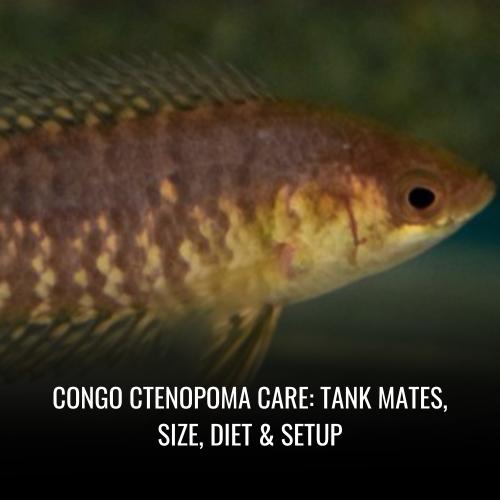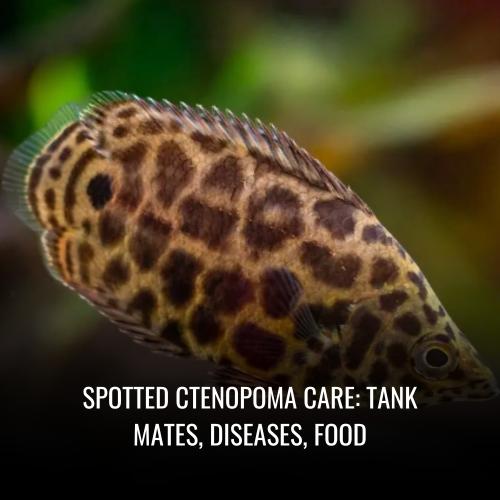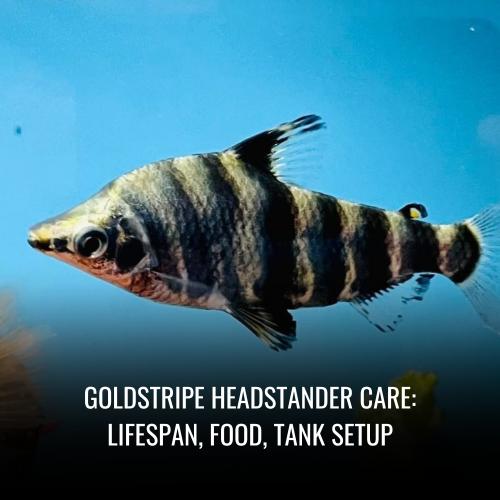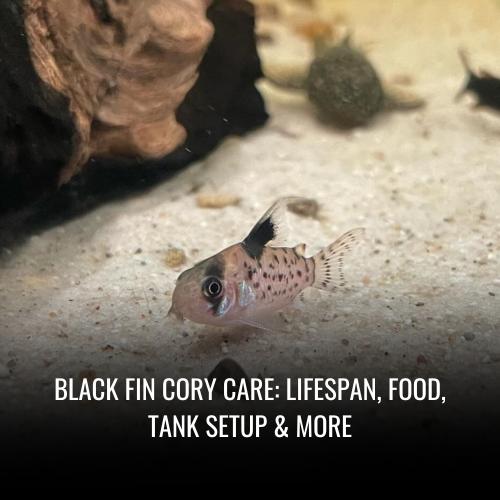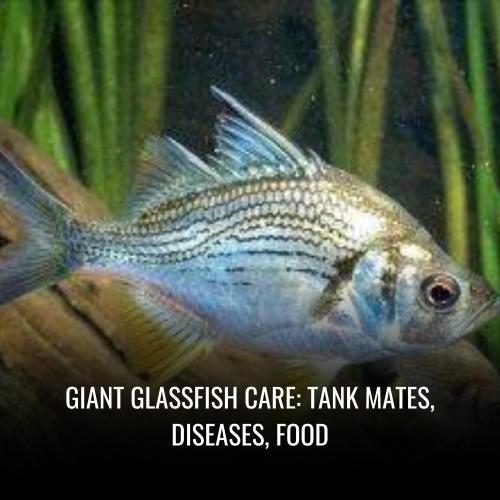Abramites eques Care: tank mates, Diseases, Food
This post contains affiliate links. As an Amazon Associate, we earn from qualifying purchases.
Abramites eques, commonly known as the Marbled headstander, belongs to the Anostomidae family and the Characiformes order. The scientific name is illustrative of its striking knight-like appearance, with ‘abramites’ referencing a type of fish and ‘eques’ meaning knight in Latin.
| Criteria | Details |
|---|---|
| Scientific Name | Abramites eques |
| Common Name | Marbled headstander |
| Family | Anostomidae |
| Usual size in fish tanks | 10-15 cm (4-6 in) |
| Recommended pH range | 6 – 7.5 |
| Recommended water hardness (dGH) | 2 – 18°N (35.71 – 321.43ppm) |
| Recommended temperature | 24-28°C (75-82°F) |
| The way how these fish reproduce | Oviparous (Egg laying) |
| Origin | Magdalena River Basin, Colombia, South America |
| Temperament to its own species | Aggressive |
| Temperament toward other fish species | Generally peaceful |
| Usual place in the tank | Middle to bottom levels |
| Lifespan | 10-15 years |
| Tank size requirement | Minimum 200 liters (52 gallons) |
| Filtration system | High efficiency due to waste from plant-based diet |
| Sexual dimorphism | Not easily distinguishable |
| Substrate cleaning | Beneficial due to their natural bottom-dwelling behavior |
Average Size
In the confines of a home fish tank, Abramites eques typically achieves a size ranging from 10 to 15 centimeters (4 to 6 inches), with some individuals growing up to 18 centimeters (7 inches) under optimal conditions. Their size is influenced by various factors, including genetics, diet, and environmental health.
Lifespan
Marbled headstanders can enjoy a relatively long life in captivity, surviving up to 15 years with proper care. Their average lifespan hovers around 10 years, but this can be extended with exceptional attention to water quality, a well-maintained habitat, and a balanced diet.
Natural Habitat
Originating from the Magdalena River basin in Colombia, Abramites eques are accustomed to living in shallow, fast-flowing waters with rocky substrates. They are found in environments that are naturally acidic and filled with dense patches of hardy plants and abundant algae, which comprise a significant part of their diet.
Appearance
The Marbled Headstander, Abramites eques, showcases an eye-catching physical structure. Its body is sleek, elongating gracefully, with a lateral line that extends from its gill covers right to the base of the tail. On its upper region, this species carries a distinct dark, marbled pattern which strikes a stark contrast against the paler hue of its underbelly. One cannot miss the distinctive slope of its forehead and the slight upward angle of its terminal mouth, attributes that contribute to its noteworthy profile.
Both the dorsal and anal fins are not only positioned toward the back of the body but also feature an elongated form, amplifying the fish’s elegant and impressive silhouette. Upon closer look, Abramites eques displays scales that capture the light, creating a shimmering iridescence that further accentuates its allure. This combination of features marks the fish as a captivating presence in any aquarium setting.
Table: Distinctive Features of Abramites eques
| Feature | Description |
|---|---|
| Body Shape | Sleek and elongated |
| Lateral Line | Extends from gills to tail |
| Color Pattern | Dark, marbled pattern on upper body with a lighter underbelly |
| Head Shape | Sloping forehead with an upward-pointing mouth |
| Fin Position | Dorsal and anal fins set towards the rear; elongated |
| Scale Appearance | Reflective, shimmering in light |
Behavior & Temperament
Abramites eques, commonly referred to as Marbled Headstanders, exhibit a dynamic range of behaviors that reflect their semi-aggressive nature. While they are known to tolerate their species, their temperament can stretch to displays of aggression under certain conditions. They are robust, active swimmers that prefer room to roam, showcasing curious and bold qualities. When housed together, they may develop a hierarchical structure, where a pecking order is established. This social dynamic is crucial to understanding their behavior and ensuring harmony within the aquarium.
To mitigate potential aggressive encounters, it is essential to provide these fish with an environment rich in hiding spots and visual barriers. This setup will accommodate their tendency towards territorial behavior, which can intensify during breeding seasons or when they are figuring out their social standings.
Table: Behavioral Traits of Abramites eques in Aquarium Environment
| Trait | Description |
|---|---|
| Aggression | Semi-aggressive; may show territorial behavior |
| Social Structure | Hierarchical; the establishment of a pecking order is common |
| Space Requirement | Spacious environment reduces conflicts |
| Aggression Management | Ample hiding spots and visual barriers help mitigate aggression |
| Fin Nipping | Less likely in a suitable environment with compatible tank mates |
| Territorial During Breeding | Increased territoriality during breeding cycles |
Are Abramites eques Fin Nippers?
The Marbled Headstander is not typically associated with fin-nipping behavior. Considered as peaceful toward other species, Abramites eques often reserve any form of aggression for their own kind rather than engaging in disruptive activities like fin nipping.
Provided with a properly maintained aquarium that caters to their needs for space and company, this species shows a much more subdued demeanor. Factors like water hardness, availability of high-quality flake food or frozen foods, and ample swimming room all contribute to a stress-free environment where the risk of fin nipping is minimal.
Are Abramites eques Aggressive To Each Other & Other Fish?
Abramites eques exhibit varying levels of aggression predominantly towards their species, especially when kept in confined spaces. Moreover, adult Marbled Headstanders can be extremely intolerant of conspecifics, which suggests that managing their environment is key to fostering congenial interactions among them.
When housed in a school within a spacious tank, their aggression tends to dissipate, allowing them to interact harmoniously with one another and other species. Nevertheless, each fish’s behavior is individual, and therefore a close observation is required to ensure a harmonious community tank.
Are Abramites eques Friendly To Each Other & Other Fish?
Unquestionably gregarious in nature, Abramites eques values the social dynamics of being in a school. They navigate their intricate social structure, establishing rankings and forging peaceful ties when maintained in appropriate conditions.
The generosity in swimming space and the selection of non-aggressive tank mates can lead to a balanced environment where friendly interactions are commonly observed. By mimicking their natural habitat with elements like hardy plants and rich in hiding spots, one can cultivate a community where Abramites eques exhibits amicability towards fellow inhabitants.
Are Abramites eques Schooling Fish?
A schooling fish by nature, Abramites eques thrives in the presence of its own species. Keeping them in groups within the confines of a large tank aligns with their social habits and can significantly mitigate stress and aggression.
In larger assemblies, they display collective behaviors and establish a complex yet peaceful social hierarchy. Hence, to suit their sociable inclinations and encourage their inherent schooling behavior, providing a spacious inhabited by a sizable group of Abramites eques is advisable.
Can You Have Just One Abramites eques In The Tank?
Abramites eques show a clear preference for shoal living, and keeping a lone individual can prompt stress and erratic behavior. Their natural inclination in the wild to form groups translates to a need for companionship and social interaction in an aquarium setting.
Keeping a solitary individual may result in a more withdrawn or overly aggressive fish, which could be detrimental to its well-being. Having a small group is essential to fulfill their social requirements, improve activity levels, and maintain a healthy state.
Do Abramites eques Need To Be In Groups?
The behavior and social structure of Abramites eques make it apparent that these fish are best suited to group living. As part of a shoal, they exhibit a stronger sense of security, showcase typical schooling behaviors, and express less aggression. This is inherent to their life cycle, where dense packs assemble in the rainy seasons of their South American habitats.
Thus, keeping groups of 6 or more is paramount not only for the mental stimulation of Abramites eques but also to prevent stress-induced complications. Conclusively, the fish’s need for companionship is a critical consideration for aquarists aiming to replicate the most favorable environment for these vibrant creatures.
Food & Diet
Abramites eques, commonly known as Marbled Headstanders, have a particularly herbivorous palate, with a notable penchant for vegetation in their diet. Their feeding habits are largely based on plant materials like algae and hardy plants found in their natural environment. These fish are extreme herbivores, signifying that algae form a major part of their consumption, both in the wild and in captivity.
To maintain their health and mimic their natural dietary patterns, aquarium diets should be rich in vegetable matter. Algae wafers, high-quality flake food formulated for herbivores, spirulina, and blanched vegetables such as spinach and peas are excellent choices. It’s important to provide a range of these foods to fulfill their nutritional needs and prevent the fish from potentially nibbling on live aquarium plants.
Table: Recommended Dietary Items for Abramites eques
| Food Type | Reason |
|---|---|
| Algae Wafers | Mimics natural grazing on algae |
| High-Quality Flake Food | Provides essential vitamins and nutrients |
| Spirulina | Offers a plant-based protein source |
| Blanched Vegetables | Adds variety and important fiber |
| Occasional Treats (e.g., bloodworms, mosquito larvae) | Offers diversity and enrichment |
Do Abramites eques Eat Algae?
Absolutely, Abramites eques have a strong inclination towards consuming algae, making up an essential component of their diets. In the wild, such as within Colombia’s Rio Magdalena, algae growth is likely abundant and provides a constant food source for these fish.
In captivity, mimicking this aspect of their habitat is crucial for their well-being. Offering them algae wafers is an excellent way to keep their diet in check and satisfy their natural herbivorous cravings.
Do Abramites eques Eat Shrimp?
While shrimp are not a natural prey for the predominantly herbivorous Abramites eques, these active fish might occasionally snack on small or baby shrimp when they are foraging. This is typically accidental rather than a deliberate hunting behavior.
Ensuring a landscape with plenty of hiding spaces and a stable environment is necessary, as any potential consumption of shrimp would more likely be opportunistic than habitual.
Do Abramites eques Eat Bloodworms?
Bloodworms are not a staple in the diet of Abramites eques, as they are mainly herbivorous. However, these fish may opportunistically feed on small invertebrates, including bloodworms. Offering bloodworms as a supplemental treat can provide a source of protein and aid in the diversification of their diet, contributing to their overall health.
Do Abramites eques Eat Mosquito Larvae?
Abramites eques are not natural predators of mosquito larvae, but they may consume them when offered as part of their diet in captivity. Incorporating mosquito larvae as an occasional treat can provide a nutritious variety and stimulate their foraging behavior, which is an enriching experience for the fish.
Do Abramites eques Eat Planaria?
Given that Abramites eques are extreme herbivores, their diet typically does not include planaria. These fish are adapted to feed on a specific range of plant-based materials, and although they might interact with these organisms within the aquarium, planaria are unlikely to be included as a significant element of their diet.
Do Abramites eques Eat Plants?
Yes, Abramites eques do feed on plants, and their natural disposition to graze makes hardy plants a vital part of their diet. It’s essential to choose resilient plant species for the aquarium that can withstand their grazing habits. This simulates their interaction with dense patches of vegetation found in their South American river habitats and maintains their dietary balance within the aquarium ecosystem.
Sexing: Male vs Female
Sexing Abramites eques can be a nuanced task due to the subtle visual differences between males and females. Typically, it is only upon maturity that the slight distinctions in body shape become discernible. Mature females often exhibit a rounder, plumper appearance, a reflection of their potential egg-bearing status. Conversely, males tend to maintain a more streamlined, slender body, which can be noticeably different from the fuller body of mature females.
When attempting to sex these fish, it is advisable to carefully compare the body depth among mature individuals. Females may present with a noticeably deeper body shape. These differences become more palpable as the fish approach reproductive age. Patience and close observation are key in determining the gender of Abramites eques, as the signs are not overt but become slightly more pronounced with age and development.
Table: Visual Differences Between Male and Female Abramites eques
| Feature | Male | Female |
|---|---|---|
| Body Shape | Slender | Plumper |
| Body Depth | Less pronounced | More pronounced when mature |
Keep in mind that while these indicators can assist in sexing Abramites eques, they are still general observations and can vary among individual fish.
Abramites eques Tank Mates
Abramites eques, commonly known as Marbled Headstander, are well-suited for community aquariums due to their bottom-dwelling habits, which allows them to share space amicably with fish that prefer other levels of the tank. When housing Abramites eques, it’s pertinent to consider their origin from South America, ensuring their needs for certain water parameters are met to thrive harmoniously alongside regional tank mates such as tetras, corydoras, and peaceful cichlids.
However, it is crucial to note their aggressive tendencies towards their own kind. To mitigate this, keeping them in schools within spacious aquariums is essential. This allows ample swimming space, reducing competition and aggression, thus making them more sociable towards non-conspecifics. As herbivores, Abramites eques get along with other gentle, plant-eating fish, including certain plecos and non-aggressive cichlids that share their dietary preference.
Table: Suitable Tank Mates for Abramites Eques
| Compatible Tank Mates | Reason for Compatibility |
|---|---|
| Tetras, Corydoras | Same regional water preferences |
| Peaceful Cichlids | Adapt to similar water conditions |
| Certain types of Plecos | Shared herbivorous diet |
| Non-aggressive Herbivorous Cichlids | Complementary peaceful nature |
| Rasboras, Dwarf Gouramis | Peaceful, occupy different tank levels |
| Peaceful Barbs | Non-aggressive, community-friendly |
Aquarium Setup
Creating the perfect aquarium setup is crucial for nurturing healthy and thriving Abramites eques. These fish, commonly known as Marbled Headstanders, hail from the dynamic ecosystems of South America’s Magdalena River. To emulate their natural habitat, it is essential to provide an aquarium layout that offers ample swimming space while replicating the specific environmental conditions they are accustomed to.
The aquarium should be fitted with a typical South American biotope design, consisting of sandy substrate and driftwood to mimic the bottom composition of the Magdalena River’s shallow and fast-moving waters. Hardy plants like Anubias and Java fern can be added for greenery. However, it is advisable to steer clear of delicate plant species that could become the Headstander’s next meal. Include branches or roots to create plentiful hiding places, giving the fish space to retreat and reducing stress.
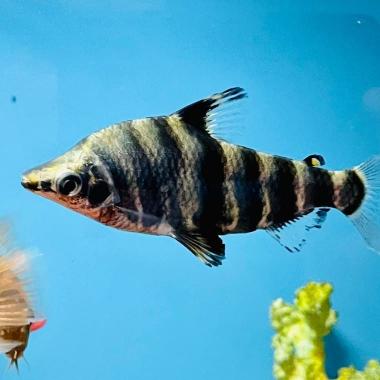
Ideal Tank Size
For a single specimen of Abramites eques, an aquarium with a length of 120 centimeters serves as a decent habitat. When considering a group, think bigger—opt for a tank that holds at least 75 gallons to give these active fish the space they need. To further alleviate territorial conflicts and aggressive encounters, a spacious tank of 100-125 gallons is the better choice. This provides adequate horizontal swimming space, which is critical for the well-being of Abramites eques, as it allows them to exhibit their natural darting behavior and exploration tendencies.
Ideal Water Parameters
Replicating the conditions of their native acidic waters is key for the health of Abramites eques. Strive for a pH range between 6.0 and 7.5 and maintain water hardness levels of 5-15 dGH. Temperature is another important factor; the ideal range for these fish is 72-79°F (22-26°C), reflective of the warm Brazilian waters they come from.
Water quality should be impeccable, with negligible ammonia and nitrite levels, achieved through diligent testing and regular water changes. To echo the fast-flowing rivers that Abramites eques are familiar with, a well-oxygenated tank with appropriate circulation and aeration is a non-negotiable aspect of their care.
Filtration
The quality of filtration cannot be overstated when it comes to Abramites eques. A robust canister filter, or a top-notch hang-on-back filter, can help maintain the crystalline water quality these fish require. Choose a filtration system that combines mechanical and biological filtration to efficiently remove detritus and support a stable nitrogen cycle.
Since Marbled Headstanders originate from river environments with substantial water current, setting up a filter that replicates this flow will contribute to their health and overall happiness. Regular maintenance of the filter is crucial to preserve its efficiency and the cleanliness of the aquarium.
Lighting
A suitably lit aquarium is fundamental to the well-being of Abramites eques and the visual appeal of their environment. LED lights are the recommended choice because they offer energy-efficient, adaptable illumination that mimics the vibrancy of natural daylight. To mimic their native sunlight exposure, keep the lights on for about 10-12 hours daily, adhering to the natural rhythm of day and night.
This light regimen not only encourages the natural behavior of Abramites eques but also supports the photosynthesis of hardy plants, thereby enhancing water clarity and contributing to a balanced ecosystem. The right lighting setup will showcase the inhabitants’ true colors and behaviors, providing aquarists with an engaging and attractive display.
Common Possible Diseases & Prevention
Abramites eques, like other aquarium fish, can fall prey to ailments such as Ich, fungal, and bacterial infections. These diseases often stem from suboptimal water quality and undue stress. Adequate prevention hinges on vigilant water care, including regular changes and filtration, coupled with vigilant checks on ammonia, nitrite, and nitrate concentrations. Quarantine procedures for new arrivals are critical in safeguarding against disease introduction.
To fortify the resilience of Abramites eques, minimize stressors by avoiding overcrowded tanks, ensuring a harmonious community of tank mates, and maintaining stable water temperature. Observing fish behavior and physical health aids in early detection and prompt disease management, ultimately curtailing the spread of pathogens.
| Prevention Strategy | Description |
|---|---|
| Water Quality Control | Regular changes, proper filtration, monitor levels |
| Quarantine New Fish | Isolate newcomers to prevent disease spread |
| Suitable Environment | Avoid overcrowding, provide hiding spaces |
| Compatible Tank Mates | Choose non-aggressive species to reduce stress |
| Stable Water Temperature | Prevent fluctuations to lower stress |
| Regular Observation | Watch for behavioral/physical changes for early signs |
Ensuring these measures will help in maintaining a thriving and disease-free environment for Abramites eques.
Breeding Abramites eques In Aquarium
Breeding Abramites eques, commonly known as the Marbled Headstander, has remained unattainable in aquarium settings. Aquarists encounter difficulties as this species, exhibiting a distinctive high body profile and reaching sizes between 15-20 cm, requires precise environmental conditions and space to replicate its natural habitat, particularly the unique ecosystem of the Rio Magdalena in Colombia, its sole distribution range.
Maintaining peace for the aggressive and territorial Marbled Headstander is essential, meaning aquarists must carefully consider tank companions and space allotment for potential breeding pairs. The fact that its closest relative, Abramites hypselonotus, inhabits a broader range across South America, while Abramites eques does not, further underscores the complexity of emulating the specific river environment it calls home.
Potential advancements in captive breeding protocols hold promise for future success. If these hurdles can be overcome, it may open avenues for sustainable aquarium propagation of Abramites eques.
| Breeding Challenges | Solutions |
|---|---|
| Limited distribution | Research natural habitat closely |
| Aggressive behavior | Spacious tanks, separate territories |
| Specific environment | Replicate river conditions, stable water parameters |
| Lack of documented breeding | Observe wild behaviors, innovate captive breeding methods |
Research and dedication may eventually lead to breakthroughs in captive breeding efforts for the enigmatic Marbled Headstander.
Are Abramites eques Easy To Keep?
Abramites eques are lauded for their resilient nature and adaptability, traits making them relatively straightforward for both novice and expert aquarium enthusiasts. These fish can thrive in a spectrum of water conditions, enduring both acidic and hard water, which is akin to the diverse aquatic environments of South America.
Their hardiness allows them to weather water parameter fluctuations with relative ease, though constant water quality remains paramount to their health and longevity. This robustness, coupled with a generally peaceful temperament, renders them compatible with various tank mates, barring those of aggressive or excessively territorial inclinations.
Given a spacious aquarium mirroring their native shallow and fast-moving river habitats, equipped with hiding nooks and robust vegetation, Abramites eques require minimal specialized attention. Regular tank upkeep including consistent feeding regimes and vigilant water quality monitoring are the foundational care practices for promoting optimal health and ensuring the sustainable presence of Abramites eques in a domestic aquatic setting.
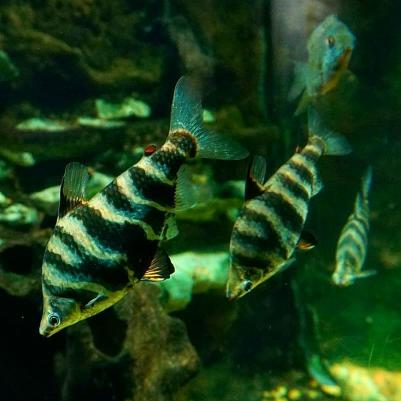
Are Abramites eques Sensitive To Water Changes?
Despite their resilient disposition, Abramites eques do exhibit sensitivity to abrupt and significant water parameter shifts. Such sudden changes, be it in temperature, pH, or hardness levels, can invoke stress and potential harm. To avert adverse effects and disease susceptibility, aquatic caretakers should take measures to recreate the fish’s natural riverine environment, safeguarding them in particular from drastic chemical upheavals.
Stress-induced symptoms like reduced feeding interest, lethargy, or an uptick in vulnerability to aggressive tank mates are telltale signs that an Abramites eques is coping with unstable water conditions. As they transition into new environments or during routine water exchanges, careful and gradual alterations in water parameters are integral to minimizing stress and fortifying the well-being of these sensitive species.
Are Abramites eques Sensitive To Ammonia?
Ammonia levels are another critical factor within an Abramites eques’ habitat, with high quantities being especially detrimental to their health. Elevated ammonia interferes with respiration, harming the gills, while concurrently upending osmoregulation—the process allowing fish to maintain the balance of salts and internal water. Consequences of excessive ammonia include listless behavior, feeding apathy, and heightened mucus production.
Maintaining diligent vigilance over ammonia concentrations is thus indispensable. Regular water testing and ongoing maintenance are imperative practices to prevent ammonia poisoning and confirm a healthful environment for Abramites eques within the confines of a tank.
Are Abramites eques Sensitive To Copper?
Copper sensitivity is a notable biological trait of Abramites eques, with even trace amounts being capable of inducing undue stress and bodily harm, impacting the respiratory and nervous systems. The use of copper-based medications and algaecides must be approached with extreme caution to prevent physiological disruption and safeguard the fish’s welfare.
This sensitivity is shared across numerous freshwater fish species, with Abramites eques potentially exhibiting respiratory distress, unconventional swimming patterns, and reduced immune effectiveness upon exposure. To curate the best possible care for Abramites eques, aquarium owners need to monitor and manage water parameters diligently, ensuring copper is kept at bay to mitigate any resultant stress or health complications.

